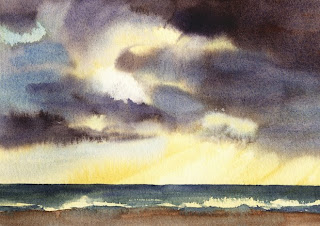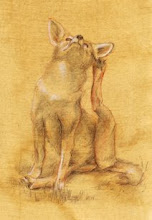
I was going to write more information about clouds, but I have been sidetracked by participating in Boulder Open Studios 2008. The past two weekends I invited the public to visit my immaculate studio so that they could view my artwork and learn about my techniques. One of the topics that I talked about was how I create a painting. Most people believe that watercolor artists just work freely with the paint without a lot of planning. Well, that is not how most watercolor artists work. My mantra is "happy accident, carefully planned." In my next couple of blogs, I will talk about the process I use to create a finished painting.
The painting that appears here is a plein aire oil sketch. It was completed in a few hours on site in Rocky Mountain National Park. What I am trying to capture is the feeling of that morning and the colors. I do not have time for detail or to work very large. I take lots of photos so that I can add the detail in the studio when I paint an enlargement of the scene. This oil sketch is only 8" X 10". The final painting will be 22" X 30" or a full sheet of watercolor paper. Why do I paint the sketch in oil and then do the final painting in watercolor? Most artists do their sketches in watercolor and then paint the final artwork in oil. Thomas Moran is an example of an artist who works that way. But every artist is different and has their quirks. I am more comfortable painting with watercolors and I prefer the way watercolors look as final paintings. I do my sketches in oil to challenge myself and force myself to see differently.
So here is the sketch and my next blog will talk about how I carefully plan a final painting from a small sketch and photographs.

